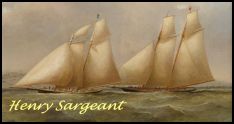Affichages : 3196
Catégorie : PEINTRES
 A marine painter working in Portsmouth in the mid-nineteenth century, who can be identified as the ‘Henry Sargent’ (son of Henry and Sarah Sargent) who was baptised at Botley, Hampshire, on 26th November 1797, after birth sometime after mid-August from his age at death (71).
A marine painter working in Portsmouth in the mid-nineteenth century, who can be identified as the ‘Henry Sargent’ (son of Henry and Sarah Sargent) who was baptised at Botley, Hampshire, on 26th November 1797, after birth sometime after mid-August from his age at death (71).
By about 1836 he held the appointment of Marine Painter to HRH the Duchess of Kent (Queen Victoria’s mother) according to inscriptions on locally published prints after his work. One issued by J. Miller of Portsmouth, presumably late in that year or in 1837, is an impressive lithograph of H.M. Brig Serpent (Commander R.J. Warren) dismasted whilst lying at Anchor at Spithead by a Tremendous Hurricane on Tuesday the 29th of Novr 1836. The appointment may have arisen in some connection from the Duchess and Princess Victoria having been at Portsmouth when they came to stay at Norris Castle, East Cowes, I.o.W. in both 1831 and 1833. When Victoria and Prince Albert made a formal royal visit to Portsmouth in early March 1842, the elaborate evening illumination of the town included ‘a beautiful transparency of the stern of her Majesty’s ship Queen’ by ‘Mr Sargeant, painter’ among those in Broad Street.
Sargeant’s prime business, however, seems to have been as a glazier, plumber and decorator, both his work and home premises being at 85 High Street, Portsmouth, according to Robson’s Hampshire directory for 1839. This lists him as ‘Marine Painter and Glazier’ and the 1841 census notes him there, aged 40, with his wife and probably his sister, both called Sarah (and stated as 35 and 26), and his six children ranging from 14 to two years old: four were boys, and girls the fourth and last. His wife was Sarah Elcock, born in 1799 at Hythe, Hampshire, and they had married on 22nd September 1817, probably at Fawley.
From some point before 1842 to at least 1845 the family were in Broad Street, Portsmouth, where Sargeant’s business failed by the latter year. Described as a ‘marine painter’ he was arraigned for insolvency that April before a Commissioner of Bankruptcy at Winchester (see Bell’s Weekly Messenger, 9th March). He somehow appears to have recovered and at the 1861 census was back in High Street (probably at no. 63) with his wife but only his eldest son, Arthur (24), also at home. His age is then more specifically stated as 63 and his wife’s as 62 and he is listed as a ‘Painter employing 3 men 1 boy’, undoubtedly meaning a painter/decorator on this occasion.
Sargeant’s parallel artistic output appears to have been largely local coastal and yachting views in oil, some exhibited in the Portsmouth area. The ‘Fine Art and Industrial Exhibition’ at Gosport in 1860 included two of his works lent by a Mr Harding, Pilot Boat – Old Agenoria and Pilot Boat – New Agenoria, while a Mr Dashwood contributed his Schooner Yacht America (Portsmouth Times and Naval Gazette, 15th September 1860). At the similar follow-up exhibition in 1861, held at the Queen’s Rooms, Portsea, the Portsmouth Times (19th October) noted that ‘Captain Parnell exhibits a very nice picture by Mr. Sargeant, a local artist of some repute, illustrative of a yacht race.’
The National Maritime Museum also has a signed oil showing the yacht ‘America’ outsailing the Marquess of Anglesey’s ‘Pearl’ in informal but reported circumstances in the Solent (not in a race) on 14th August 1851. Some uncertainty is introduced by there also appearing to be a marine painter called Sargeant working in a similar style, but showing later shipping, in the 1880s. There is also a landscape view of Taunton, looking towards the Quantock Hills in the Somerset Museum of Rural Life, attributed to a ‘Sargeant’ with working dates stated as c.1835–41. This is so different in subject terms that it is hard to take a view on whether by the Portsmouth man, given lack of comparable examples.
Sargeant’s wife predeceased him on 25th October 1867 and on 29th January 1868 he was again declared bankrupt with his address given as 63, High Street, Portsmouth. In mid-February 1868 he was again before the local court for an interim hearing, described as ‘a painter, plumber, and glazier’ (Hampshire Telegraph, 19th February). The report continues, ‘The bankrupt stated that he had been in business for 50 years, and his present difficulties he attributed to sickness of himself and family and badness of trade. His liabilities amount to 156l. 3s. 9d., and the assets, consisting of furniture and stock-in-trade, were estimated to realise about 19l., in addition to 44l. 7s. 7d. book debts, most of which were stated to be good.’
He was told to appear for final resolution of the case on 30th March but matters were still being resolved the following January, well after his death in Portsmouth on 13th August 1868, just short of 72.


